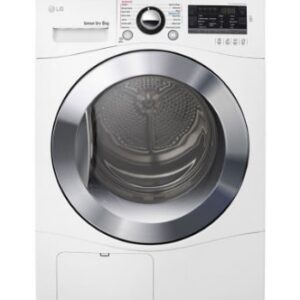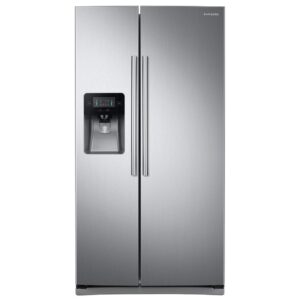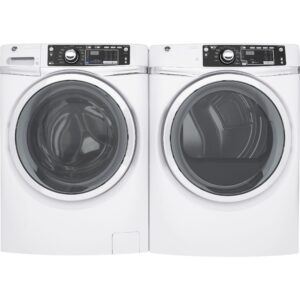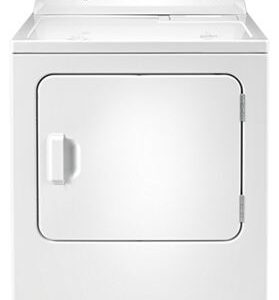Ready to slash your utility bills? Energy Star-certified washers save 25% on energy costs while their dryer counterparts cut energy use by 20%. These savings add up quickly on your monthly bills.
Smart shoppers know – spending just $100-$150 more upfront often makes the difference between basic and exceptional performance. Today’s washers come in sizes from compact 2.5 cubic feet to spacious 6.2 cubic feet models. Dryers offer even more room, ranging from 3.4 to 9.2 cubic feet. But size isn’t everything – choosing the right features matters more for your specific laundry needs.
Let’s walk through the must-have money-saving features, compare popular models, and uncover those sneaky costs that could impact your budget. Whether you’re replacing old appliances or furnishing a new home, this guide helps you pick the perfect washer and dryer combo that saves money year after year.
Understanding Basic Washer Types
Want cleaner clothes while saving money? Your choice between front-load and top-load washers makes a big difference. Front-load washers excel at stain removal thanks to their smart tumbling action. Plus, they use 5 fewer gallons per wash than high-efficiency top-loaders – that’s 2,000 gallons saved every year.
Top-load vs front-load efficiency
Let’s talk real savings. Front-load washers crush their top-loading rivals in efficiency tests. They slash energy use by 45% and water consumption by 50% compared to old-school agitator models. Even against modern high-efficiency top-loaders, front-loaders still win by saving 25% more on both water and energy.
Shopping for a top-loader? You’ll find two types: traditional agitator models and newer impeller designs. The impeller version swaps the tall agitator for a sleek low-profile cone, boosting efficiency. But here’s the truth – even these upgraded top-loaders can’t match front-loading performance.
The secret lies in how they clean. Front-loaders gently tumble clothes, creating friction that attacks dirt and stains. Top-loaders depend on either an agitator or impeller to push clothes through water. That gentle tumbling action? It’s easier on your favorite outfits too.
Size and capacity considerations
Size matters when picking your perfect washer. Here’s what different capacities mean for your laundry routine:
- Small (3.5-4.4 cubic feet): Handles 9-15 bath towels
- Medium (4.5-4.9 cubic feet): Fits 11-19 bath towels
- Large (5.0-5.3 cubic feet): Tackles 12-21 bath towels
Got king-size bedding? You’ll need at least 4.6 cubic feet to wash those bulky comforters. Most front-loaders offer up to 5.0 cubic feet, though some premium models go bigger.
Here’s a bonus – front-loaders and high-efficiency top-loaders skip the space-hogging agitator. More room means fewer loads, saving time and money on utilities.
Impact on utility bills
Your washer choice shows up on every utility bill. Surprise fact: 90% of washing machine energy goes to heating water. Front-loaders tackle this with faster spin speeds and smarter water use.
ENERGY STAR certified washers prove their worth every month. They cut energy use by 25% and water consumption by 33% versus standard models. That adds up to 284 kWh and 3,385 gallons saved yearly – putting $60 back in your pocket.
Smart shoppers check two key ratings: IMEF (Integrated Modified Energy Factor) and IWF (Integrated Water Factor). Higher IMEF scores mean better overall efficiency, measuring everything from cycle energy to water heating. For IWF, lower numbers show better water efficiency per cubic foot.
New rules push efficiency even further. Top-loaders must now cut energy use by 10%. The good news? ENERGY STAR top-loaders aren’t just efficient – they clean better too, scoring 4.1 versus 3.1 in Consumer Reports tests.
Key Money-Saving Features to Look For
Today’s washers and dryers pack smart technology that puts real money back in your pocket. These clever features work hard to trim your utility bills while delivering exceptional cleaning power.
Energy Star certification benefits
The familiar Energy Star label means serious savings – these washers cut energy use by 20% and water consumption by 30% compared to standard models. Over their lifetime, certified machines save about $550 on energy costs. Picture this: while regular washers gulp down 20 gallons per load, Energy Star models need just 14 gallons to get the job done.
Don’t worry about trading performance for efficiency. These certified machines meet rigorous standards while delivering superior results. Front-load Energy Star washers really shine – they slash energy use by 45% and water consumption by 50% versus traditional agitator models. Your wallet and the environment both win.
Water usage optimization
Modern washers are water-saving champions. Their auto-sensing technology works like a smart detective, figuring out exactly how much water your clothes need based on load size and dirt level. Less water means less heating – and that means lower bills.
Want maximum efficiency? Check the Integrated Water Factor (IWF) rating. Think of it as your water-saving scorecard – lower numbers mean better performance. Some cutting-edge models even recycle water, cutting consumption by up to 85%.
Smart sensors and auto-adjustments
These machines are smarter than ever, with features that take the guesswork out of laundry:
- Load Size Detection: Built-in sensors weigh your clothes and measure drum resistance, adjusting water use perfectly every time
- Moisture Monitoring: Your dryer now knows exactly when clothes are dry, stopping automatically to prevent energy waste and protect fabrics
- Detergent Optimization: Advanced models use smart tech to scan detergent types and dispense just the right amount – no more waste or poorly cleaned clothes
But that’s not all. Your washer and dryer can now talk to each other, automatically selecting the perfect dry cycle based on what you just washed. Some models even remind you about lint filter cleaning and warn you about vent blockages.
Looking for peak efficiency? Consider machines with i-DOS technology that measures exact detergent needs based on fabric type and soil level. The newest models even tap into EEBUS energy management, running cycles when electricity rates drop or your solar panels are producing power.
These smart features might cost more upfront, but they quickly pay for themselves. Studies show households save around $40 yearly just from shorter drying times. Add in water and energy savings, and you’re looking at significant long-term benefits.
Essential Dryer Features Worth the Investment
Smart dryer technology saves money and protects your favorite clothes. These game-changing features deliver better performance while cutting energy costs month after month.
Moisture sensors explained
Think of moisture sensors as your dryer’s smart brain. These clever devices watch over your clothes throughout each cycle, using two key methods to spot dampness: conductivity sensors check electrical resistance while humidity sensors track moisture in the air.
Your dryer’s triple-check system works like this:
- One sensor watches incoming air temperature
- Special strips in the drum feel clothing moisture
- A final sensor monitors outgoing air temperature
This three-way verification hits the sweet spot – clothes dry perfectly without damage. The sensors adjust drying time automatically, shutting off right when your clothes reach ideal dryness.
Keep those sensors working their best. Fabric softener residue and lint can throw off readings. A quick wipe with rubbing alcohol every few months keeps them working like new.
Heat pump vs traditional technology
Heat pump dryers mark a huge leap forward in drying technology. These smart machines slash energy use by 70% compared to regular dryers. While standard electric dryers gulp down 700-1000 kilowatt-hours yearly, heat pump models sip just 200 kWh.
Here’s how this clever technology works:
- Air flows in and grabs moisture from wet clothes
- An evaporator pulls water from this air
- The same warm air gets recycled back to your clothes
Unlike old-school dryers that waste warm air outside, heat pump models recycle it efficiently. No outside vent needed means flexible installation options. Plus, lower drying temperatures treat your clothes more gently.
What you should know about heat pump dryers:
Cost vs Savings: Yes, they cost more upfront – but major energy savings follow. ENERGY STAR certification proves their efficiency.
Easy Installation: Skip expensive vent work installation. Just choose between a drain hookup or emptying a water tank after cycles.
Drying Speed: Today’s models finish in 35-80 minutes, matching traditional dryers. Want faster drying? Hybrid versions combine heat pump efficiency with traditional heating power.
Earth-Friendly Operation: These dryers use refrigerants, but newer models choose low Global Warming Potential options like R-290.
The technology keeps getting better. Manufacturers now offer standard-size models perfect for American homes. With about ten models available and more hybrid versions coming, you’ll have plenty of choices.
Hidden Costs to Consider
Let’s talk about those sneaky expenses that pop up after buying your washer and dryer. Knowing these costs upfront helps you plan better and avoid budget surprises down the road.
Installation requirements
Professional installation costs look reasonable at first – USD 100.00 to USD 300.00 if your home has existing hookups. But here’s the catch – need new plumbing or electrical work? That bill could jump to USD 650.00 to USD 2,000.00.
Before scheduling delivery, check these must-have requirements:
- Water shut-off valves within 6 feet of your washer
- Properly secured electrical outlets on walls or floor
- Dryer vent connection to 4-inch rigid pipe (8-foot maximum)
- Garage setups need dryers 18 inches above the parking area
Safety first – always hire licensed pros for tricky installations. Here’s a money-saving tip: delivery teams must use new parts, so factor these into your budget. Using existing parts isn’t an option, even if they’re perfectly good.
Maintenance expenses
Think of maintenance like regular oil changes for your car – skip it, and you’ll pay more later. Service calls start at USD 50.00 to USD 100.00 just for the tech to show up. Typical repair costs look like this:
- Basic washer fixes: USD 70.00 to USD 500.00
- Standard refrigerator repairs: USD 200.00 to USD 300.00
- Emergency calls: USD 120.00 to USD 500.00 per visit
Good news – proper care stretches your appliance life to 8-13 years. Just stick to manufacturer guidelines – DIY repairs might void your warranty and cost more in the long run.
Extended warranty value
Should you buy that extended warranty? Let’s break it down. Plans range from USD 20.00 for small appliances to USD 150.00 for larger ones, sometimes hitting USD 500.00 for premium models.
Here’s what you’re buying:
- Protection plans from one to five years
- Some companies only offer shorter 1-2 year coverage
- Sweet spot: warranty cost around 15% of appliance price
Many third-party warranty companies partner with local repair pros, ensuring quality service. But watch for these gotchas:
- No coverage for certain problems like broken belts or scratches
- Skipped maintenance requirements could void your warranty
- Some policies cut replacement value by 20% yearly
Here’s something to think about – 78% of Americans live paycheck to paycheck, making surprise repair bills tough to handle. Companies like Upsie get this, offering deals like USD 129.99 for five years of coverage on a USD 600.00 washer.
Smart shopper tip: check cancellation rules carefully. Most stores give you 30-90 days to change your mind. Also, don’t double-pay – make sure extended coverage starts after your manufacturer’s warranty ends.
How to Compare Models Effectively
Yellow EnergyGuide labels hold the secret to smart appliance shopping. These efficiency ratings help you spot money-saving machines and dodge energy-hungry models that drain your wallet every month.
Reading energy labels
That bright yellow EnergyGuide label – mandatory for 40+ years – tells you exactly what to expect in running costs. Three key numbers matter most:
- Yearly Operating Cost: See real dollar estimates based on typical household use
- Cost Comparison Bar: Shows how this model stacks up against similar appliances
- Annual Power Usage: Your estimated kilowatt-hour (kWh) consumption
Quick tip: Washer estimates assume six loads weekly. Your actual costs? They’ll vary based on local utility rates and laundry habits. Remember, these numbers include both machine power and water heating costs.
Understanding efficiency ratings
Two rating systems cut through the marketing hype: CEE ratings and ENERGY STAR certification. For dryers, watch the Combined Energy Factor (CEF) – higher means better efficiency. Washers use Modified Energy Factor (MEF) and Water Factor (WF) scores.
Today’s efficiency grades run from ‘A’ to ‘G’ – simpler than the old A+++ to D system that changed in March 2021 [87,88]. Here’s what those grades mean:
- ‘A’ grade machines beat even old A+++ models for efficiency
- ‘B’ rated units offer great savings without premium prices
- ‘D’ rated appliances? They work, but your bills will show it
Smart shoppers check three key factors:
- Water Usage: Look for low IWF numbers – less water per cubic foot means better efficiency
- Power Consumption: Based on 100 cycles of Eco 40-60 washing
- Load Testing: Performance checks at full, half, and quarter loads
Want maximum savings? Look for both ENERGY STAR certification and strong efficiency scores. ENERGY STAR certified appliances rank among the top 25% for efficiency. They must hit these marks:
- Washer MEF: 2.0 minimum
- Water Factor: 6.0 maximum
- Dryer CEF: At least 3.93 for CEE tier 1
These ratings affect your bottom line – running costs swing from 10p to 36p per load based on efficiency. Don’t overstuff – it kills efficiency over time. Pick the right machine and use it properly for best results.
Long-term Savings Strategies
Want your washer and dryer to last longer while slashing utility bills? Smart usage habits and regular maintenance could save you hundreds each year. Here’s your money-saving game plan.
Optimal usage practices
Full loads pack the biggest savings punch. Your washer uses the same energy whether it’s half-empty or full. The sweet spot? Load up to capacity while leaving enough room for clothes to dance around freely.
Cold water washing might be your best-kept savings secret:
- Colors stay bright, fabrics last longer
- Modern detergents work great in cold water
- Dodge that massive 90% energy hit from heating water
Here’s a shocker – most people use way too much detergent. One humble tablespoon cleans an eight-pound load perfectly. Overdoing it? You’re asking for trouble:
- Machine works overtime with extra rinse cycles
- Gunky buildup on clothes and washer parts
- Clothes come out stiff instead of soft
Money-saving pro tip: Time your laundry right. Early birds and weekend warriors catch the cheapest electricity rates. Running back-to-back dryer loads? Smart move – you’re using already-warm air for better efficiency.
Maintenance tips for longevity
Think of maintenance like a savings account – small, regular deposits pay big dividends. Your washer needs:
- Level Check: Monthly stability checks prevent damage from that intense 1,600 RPM spin. Take five minutes to level those feet front-to-back and side-to-side.
- Moisture Control: Front-loader owners, wipe those gaskets dry and crack the door open between loads. Top-loader? Pop that lid open for fresh air.
- Deep Clean: Monthly tub-clean cycles keep things fresh. No tub-clean feature? Run hot water with bleach, then rinse extra well. Don’t forget those detergent dispensers.
- Hose Health: Five-year hose checkups prevent floods. Spot cracks? Replace immediately – water damage isn’t worth the risk.
Your dryer deserves attention too:
Lint Patrol: Every load needs a lint filter cleaning. Deep clean that screen twice yearly – fabric softener buildup is sneaky. This simple habit:
- Speeds up drying time
- Keeps parts running cool
- Stops fire hazards cold
Vent Victory: Ditch those flimsy accordion ducts for solid metal ones. Annual vent cleaning keeps things flowing:
- Pop off that duct
- Vacuum like you mean it
- Scrub with a vent brush
- Check all connections
Drum Care: Six-month drum cleanings with mild soap keep sensors working right.
Follow these tips and your machines could serve faithfully for 8-13 years. Skip maintenance? Emergency repairs run USD 120.00 to USD 500.00 per visit. Regular care puts about USD 60.00 back in your pocket yearly through lower utility bills.
Don’t forget those door seals – check them often and keep them clean. Remember the golden rule: never overstuff. Clothes need breathing room to get truly clean and dry. Treat your machines right, and they’ll keep your clothes fresh while keeping costs down.
Conclusion
Ready to slash those utility bills? Today’s smart washers and dryers pack money-saving punch. Energy Star models alone cut your power use by 25% and water bills by 33%. These savings add up fast, making that upfront investment look smarter every month.
Modern laundry tech amazes – moisture sensors that know exactly when clothes are dry, load sensors that measure just-right water levels, and heat pump systems that recycle energy like magic. Take good care of these smart features, and your machines could serve faithfully for 8-13 years without breaking the bank on repairs.
Smart shopping starts with those yellow EnergyGuide labels. They’re your crystal ball for future operating costs. Match those efficiency ratings with your budget and laundry needs. Then keep your investment paying dividends through regular maintenance and savvy usage habits.
Remember – your washer and dryer aren’t just appliances. They’re hard-working investments that keep your family looking sharp while protecting your wallet. Choose wisely, care for them properly, and enjoy years of reliable service and steady savings. Your future self will thank you.
FAQs
Q1. What are the key features to look for in an energy-efficient washer and dryer? Look for Energy Star certification, which indicates the appliance uses 25% less energy for washers and 20% less for dryers compared to standard models. Other important features include moisture sensors, auto-adjusting water levels, and heat pump technology in dryers.
Q2. Is it better to buy a new or used washer and dryer set? Both options have pros and cons. New appliances offer the latest energy-efficient technologies and warranties, while used models can be significantly cheaper. If buying used, look for reliable brands and consider purchasing from appliance repair shops that may offer short-term warranties.
Q3. How can I reduce energy costs when using my washer and dryer? Use cold water for washing whenever possible, as 90% of a washing machine’s energy goes to heating water. Run full loads, use the appropriate cycle settings, clean the dryer’s lint filter regularly, and consider air-drying clothes when weather permits to save on dryer energy costs.
Q4. What capacity washer and dryer should I choose for my household? For a family of four, look for a washer with a capacity between 4.5-5.0 cubic feet. This size can handle 11-21 full-size bath towels per load. Ensure your dryer has a slightly larger capacity than your washer to accommodate the expanded volume of wet clothes.
Q5. How important are extended warranties for washers and dryers? Extended warranties can provide peace of mind but aren’t always necessary. They typically cost between $20 to $150 for large appliances. Consider the warranty if it’s priced around 15% of the appliance’s retail cost. However, many issues can be prevented through regular maintenance and proper use of the appliances.












